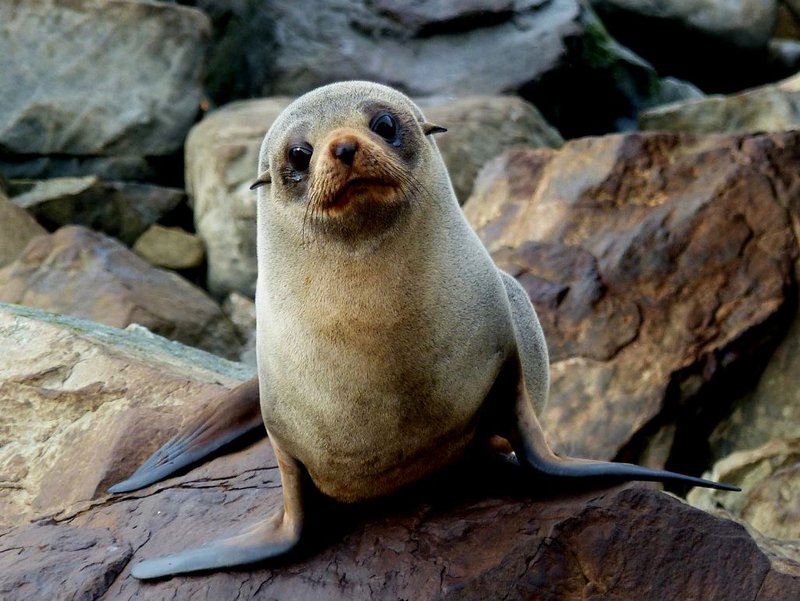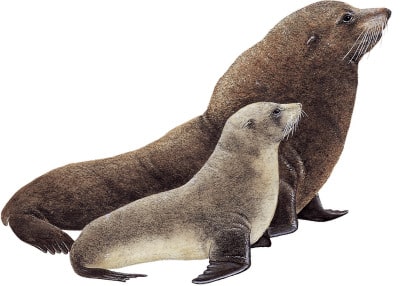HABITAT AND GEOGRAPHIC RANGE
Fur Seals are found all throughout the Southern Ocean around Australia and New Zealand, as well as parts of the Pacific and Indian Ocean coasts and islands in the subantarctic. They prefer rocky or boulder-strewn beaches, often on islands, that are somewhat secluded from humans. They occasionally venture to more vegetated areas when on land, often in dunes or outcrops behind the beach.
Distribution would be described as clumped as they stick together in colonies when on land. In water, they usually stay within or on the slope of the continental shelf and are generally not considered migratory, however, there are cases where seals (even pups) will travel great distances, sometimes between Australia and New Zealand. Each year they return to the same place for the breeding season.
The habitat featured here is one of the twenty breeding colonies in Western Australia, Chatham Island. It has a number of discrete rookeries and is ideal with its sheltered bays and granite boulders. Seals have also been seen further east around Saddle and Goose Islands and Castle Rocks, as well as in the Nornalup Inlet. Currently, the marine area is unprotected.
DESCRIPTION
Coat varies with age, but adults will generally have a grey-brown coat that is lighter at the bottom half of their body. The muzzle is also paler and can be more rust-coloured than the rest of the body, so too can the pinnae (ear flaps, this characteristic makes the seals part of Family Otariidae, ‘eared seals’). Flippers are usually a much darker brown. Fur can also have a white tip, making the coat appear silver when dry.
Adult males will have a ‘mane’ of stronger, courser fur that covers the neck, chest and shoulders. Females are usually paler and slimmer in these areas and do not have thick hair. Pups are born black with a grey to whiteish muzzle.
Fur seals actually have two coats, the outer layer of fur (described above) is meant for camouflage, whilst the underlayer is thicker and meant for warmth. New Zealand Fur Seals can be distinguished from other fur seals by their pointed nose, darker pinnae, length of flippers and the ability to rotate their hindlegs forward, however, mistakes are often made as these distinctions are very subtle.
Compared to sea lions the differences are more obvious, with sea lions having less pronounced pinnae and shorter toes on the hind flippers, as well as lighter colouration. They have small heads that merge into the rest of the body without a defined neck. A long, flattish muzzle is topped with a large nose (more bulbous on males) and long white vibrissae (whiskers) that extend past the ears. Female seals can grow up to 1.5m in length and weigh 30-50 kg, with males up to 2.5m, weighing between 90-150 kg.
DIET
Fur Seals are opportunistic carnivorous (piscivores and molluscivores) and eat a variety of marine life and sea birds. In Western Australia, they have been seen to eat squid, octopus, schooling fish and occasionally penguins and shearwaters (both the little penguin and flesh-footed shearwater breed on the island). New Zealand Fur Seals dive the deepest of all fur seals, especially when feeding off the continental shelf. Although around 45km away, continental shelves and deep-sea canyons are known to be substantial feeding grounds for many species, and New Zealand Fur Seals often spend days on fishing trips and can dive down up to 230m.
| CLASSIFICATION | |
| Domain | Eukarya |
| Kingdom | Animalia |
| Phylum | Chordata |
| Subphylum | Vertebrata |
| Class | Mammalia |
| Subclass | Eutheria |
| Order | Carnivora |
| Suborder | Caniformia |
| Family | Otariidae |
| Genus | Arctocephalus |
| Species | forsteri |
FOOD CHAIN
Fur Seals have a few predators, mainly great white sharks, orcas (which can be quite common in these areas), leopard seals (rarely seen in these areas) and sea lions. Hunting in the 19th century for the seal’s coats was extremely devastating, though now the population in Western Australia has sprung back and is nearing carrying capacity.
Cases, where humans are directly killing seals, are more often accidents where seals are caught in nets or lines. This hasn’t been reported in the area around Chatham Island and marine biologists believe this is the case for the population on the South Coast of WA. Through adaptation, the Fur Seal has a dark, camouflaging coat to protect itself against predators.
The seals also harbour a number of parasitic bacteria and parasitic animals like lungworms, respiratory mites and roundworms.
Trophic cascade is hard to measure as many prey and predator species population are massively impacted by humans.
REPRODUCTION AND LIFE CYCLE
Mating season starts in mid-November through to January, where socially mature males have already been living in the breeding area. At the start of the season, two males will compete in ritualised ‘neck displaying’, where they lift themselves off the ground and display their necks. Whoever has the thickest neck wins, but sometimes smaller males will not back off. In this case, they start to ‘wave’ their necks, trying to assert strength and aggression.
The actual fighting is rare. Males (bulls) will create a harem (group) of up to eight females (cows) and can be incredibly protective, making their chest upright as a sign of dominance and to prevent escape. Pups from the previous year are born in mid-December to early January. The gestation period is nine months, however, because of delayed implantation, the fertilised egg does not enter the uterus for three months.
This is to prevent birth when females are at sea (which happens more often in other times in the year). Fur Seals are precocial, and pups are born around 60 cm long. They stay with their mother for around 10 weeks, after which they roam around rookeries. Pups love to play with their mothers, which often consists of mouthing each other’s faces and necks. At around two months they enter the water in shallow areas or rock pools and learn to swim.
Over the next year, they learn to dive and forage and hunt for themselves and are usually weaned after one year. This is also the state where they are become sexually dimorphic (males are bigger than females). Adults become sexually mature at around 5 or 6 years, but males do not become socially mature until around 8 or 9, which is when they are able to keep a harem and sire pups. Females will live usually for 12 years, and males to 15.
REFERENCES
Marine wildlife of southern WA Identification Guide, Department of Environment and Conservation, Government of Western Australia (04/2012). Available at: https://www.dpaw.wa.gov.au/images/documents/conservation-management/marine/Marine_Life_of_Southern_WA.pdf (retrived: 14/04/21)
New Zealand Fur Seal, Dr Sandy Ingleby, Australian Museum (09/12/20). Available at: https://australian.museum/learn/animals/mammals/new-zealand-fur-seal/ (retrived: 14/04/21)
New Zealand Fur Seals, MarineBio Conservation Society. Available at: https://marinebio.org/species/new-zealand-fur-seals/arctocephalus-forsteri/ (retrived: 14/04/21)
Arctocephalus forsteri New Zealand fur seal, Dorothy Landgren, Animal Diversity Web (2013). Available at: https://animaldiversity.org/accounts/Arctocephalus_forsteri/ (retrived: 14/04/21)
Types of Seals, Australian Fur Seals, Phillip Island Nature Parks. Available at: https://www.sealeducation.org.au/about_aust_fur_seals/types_of_seals/which_seal_is_that.html (retrived: 14/04/21)
New Zealand Fur Seal, Animalia. Available at: https://animalia.bio/new-zealand-fur-seal (retrived: 14/04/21)
New Zealand fur seal, Sue Wilson, Seal Conservation Society (2008). Available at: https://www.pinnipeds.org/seal-information/species-information-pages/sea-lions-and-fur-seals/new-zealand-fur-seal (retrived: 14/04/21)
Facts about New Zealand fur seal, Department of Conservatin Te Papa Atawhai, New Zealand Government. Available at: https://www.doc.govt.nz/nature/native-animals/marine-mammals/seals/nz-fur-seal/facts/ (retrived: 14/04/21)
Noongar Maambakoort, Charmaine Councillor, Noongar Boodjar Language Cultural Aboriginal Corporation. Available at: http://noongarboodjar.com.au/wp-content/uploads/2017/10/Ocean-Pack.pdf (retrived: 14/04/21)
Arctocephalus forsteri (Lesson, 1828), Atlas of Living Australia. Available at: https://bie.ala.org.au/species/urn:lsid:biodiversity.org.au:afd.taxon:228103e0-89a0-427d-b82c-c89d494f3611#overview (retrived: 14/04/21)
Changes in the abundance and distribution of the New Zealand fur seal (Arctocephalus forsteri) in Western Australia: are they approaching carrying capacity? Richard Campbell, David Holley, Peter Collins, Shannon Armstrong, Australian Journal of Zoology, CSIRO Publishing (2014). Available at: https://www.publish.csiro.au/zo/zo14016 (retrived: 14/04/21)
Comparative assessment of amphibious hearing in pinnipeds, Spinger Link (6/4/16). Available at: https://link.springer.com/article/10.1007/s00359-013-0813-y (retrieved: 28/04/21)


